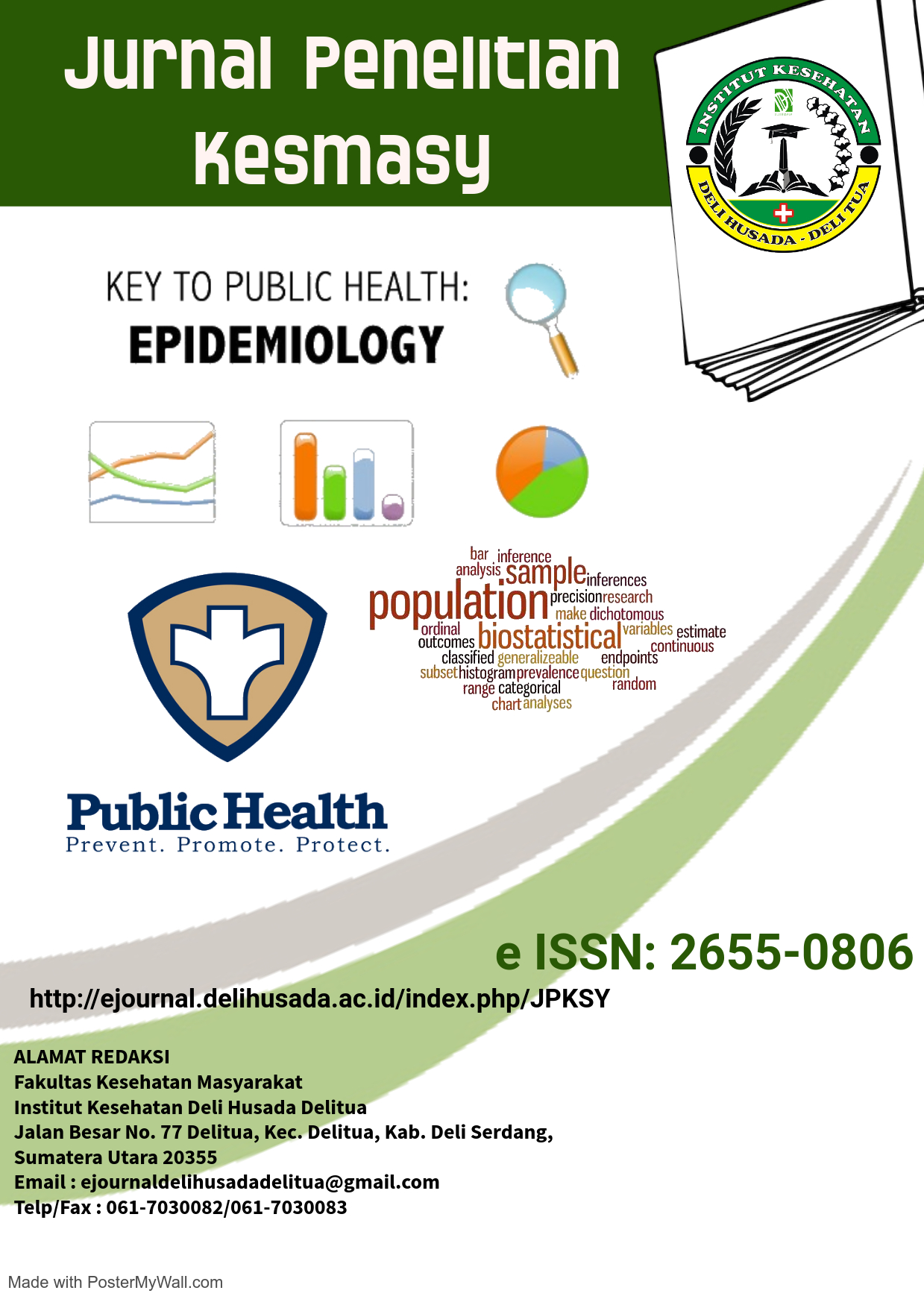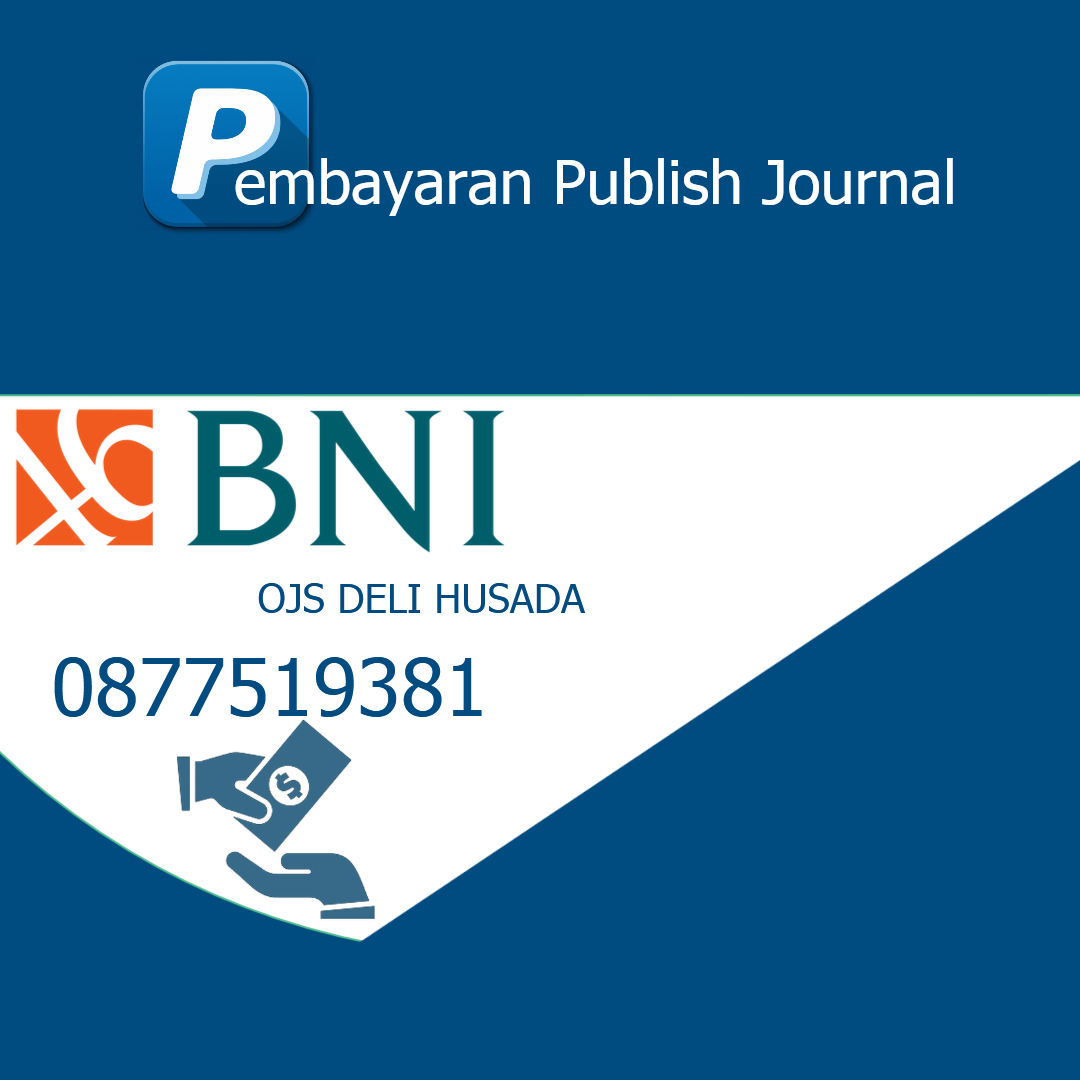HUBUNGAN PENERAPAN KAWASAN WAJIB MENCUCI TANGAN DENGAN PERILAKU PERSONAL HYGIENE PEGAWAI PADA MASA PANDEMI DI KELURAHAN SEI KERA HILIR II MEDAN
Abstract
Hands are one of the media where the entry of germs. One of the diseases that can be transmitted through hands is Covid-19. Minimizing the risk of disease transmission can be done by improving personal hygiene by washing hands, especially during this pandemic. This study is to analyze the relationship between the application of the mandatory hand washing area and the personal hygiene behavior of employees during the pandemic in Sei Kera Hilir II Village, Medan in 2021. This type of research is analytic with a cross sectional approach which is carried out by collecting data through questionnaires. Sampling with the Total Sampling technique as many as 25 respondents. Data processing with chi square test. Statistical tests show that of the 25 respondents in Sei Kera Hilir II Medan, there are 16 respondents (64%) who have good knowledge about the importance of implementing mandatory hand washing areas, 7 respondents (28%) who have sufficient knowledge about the importance of implementing mandatory hand washing areas and 2 respondents (8%) who have less knowledge about the importance of implementing mandatory hand washing areas. There are 9 respondents (36%) who have good personal hygiene behavior, there are 14 respondents (56%) who have sufficient personal hygiene behavior and there are 2 respondents (8%) who have poor personal hygiene behavior. From the results of the statistical test, the p value = 0.005 or <0.05. So from these results, H0 is rejected and Ha is accepted. This shows that there is a relationship between the knowledge variable about the application of the mandatory hand washing area and the personal hygiene behavior of employees in Sei Kera Hilir II Village in 2021. There is a significant relationship between the application of the mandatory hand washing area and personal hygiene behavior.
References
Tandra, Hans. 2021. Virus Corona Baru Covid-19. Jakarta : Rapha Publishing
Notoatmodjo, 2014. Metodologi Penelitian Kesehatan. Jakarta : Rineka Cipta
https://humanhealth.iaea.org//HHW/covid19/webinars.html
https://www.astro.org/Daily-Practice/COVID-19-Recommendations-andinformation/Clinical-Guidance
Wiguna, Candra. 2014. Perilaku Hidup Bersih dan Sehat Untuk Anak Sekolah.
Jakarta : Nuha Medika
“Update Covid-19 di Indonesia September 2021”. Kompastribunjogja.com. 19 september 2021, 16.27. https://jogja.tribunnews.com/2021/09/19/update-covid-19di-indonesia-19-september-2021-rekor-penambahan-kasus-baru-total-kini-jadi240687.
Gracia Risnawaty. 2016. Faktor Determinan Perilaku Cuci Tangan Pakai Sabun (CTPS) Pada Masyarakat di Tanah Kalikedinding. Jurnal Mahasiswa Fakultas Kesehatan Masyarakat Universitas Airlangga. 4(1) : 70-81.
Verarica Silalahi. 2017. Personan Hygiene Pada Anak SD Desa Merjosari 3.
Jurnal Mahasiswa Ilmu Kesehatan Masyarakat Universitas Tunggadewi. 2(2)
Ratna, dkk.2015. Tingkat Pengetahuan Dan Sikap Tentang Cuci Tangan Pakai
Sabun (CTPS) Pada Siswa SDN Batuah I Dan III Pagatan.Jurnal Keperawatan.Naskah Publikasi. Tersedia dalam : https://ppjp.unlam.ac.id(Diakses pada 3 Maret 2017).
Priyoto, 2015. Perubahan Dalam perilaku Kesehatan. Yogyakarta : Graha Ilmu.
Agustina. 2004. Pengaruh Pelatihan Mencuci Tangan Terhadap Perilaku
Mencuci Tangan Kelas IV di SDN Wijirejo II Wijirejo Pandak Bantul.Skripsi.Naskah Publikasi.Tersedia dalam : http://opac.unisayogya.ac.id(Diakses pada 3 Maret 2017).
Nursalam, 2015, Metodelogi Penelitian Ilmu Keperawatan Pendekatan Praktis, Edisi 4, Salemba Medika, Jakarta
World Health Organization W. Naming the coronavirus disease (COVID-19) and the virus that causes it [Internet]. 2021 [cited 2021 Apr 6]. Available from: https://www.who.int/emergencies/diseases/novel-coronavirus-2019/technicalguidance/naming-the-coronavirus-disease-(covid-2019)-and-the-virus-that-causesit
Liang W, Guan W, Chen R, Wang W, Li J, Xu K, et al. Cancer patients in SARSCoV-2 infection: a nationwide analysis in China. Lancet Oncol. 2021;21(3):335–7
Rothan HA, Byrareddy SN. The epidemiology and pathogenesis of coronavirus disease (COVID-19) outbreak. Journal of Autoimmunity. Academic Press; 2021. p. 102433.
M, A wawan dan Dewi.2017. Teori & pengukuran Pengetahuan, Sikap, dan
Perilaku Manusia. Yogyakarta: Nuha Medika
Yuni, Natalia Erlina. 2016. Buku Saku Personal Hygiene.Yogyakarta: Nuha
Medika
Pauzan, dkk. (2017). Hubungan Pengetahuan Dengan Perilaku Cuci Tangan iswa Di Seklah Dasar Negeri Kota Bandung. 5(1), 18-23.
Kementerian Pendidikan Dan Kebudayaan. (2018). In Pedoman Pengembangan Sanitasi Sekolah Dasar. Jakarta.







